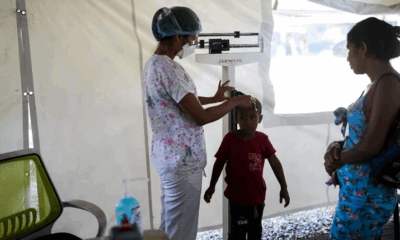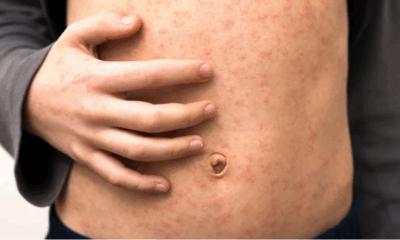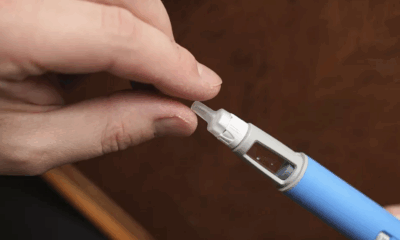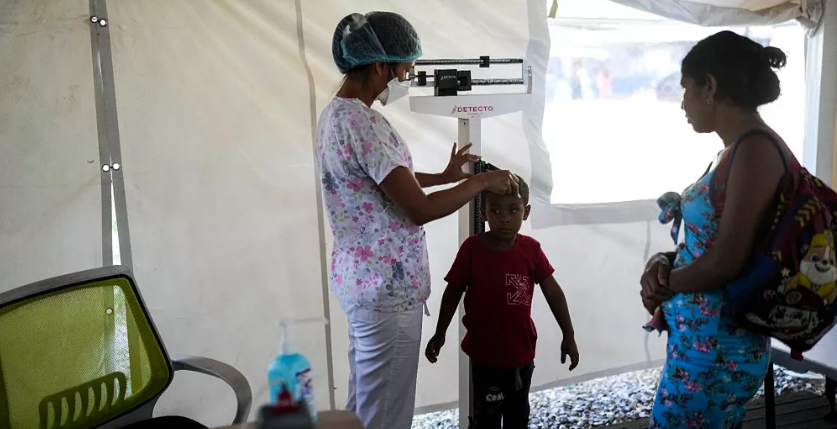Health
EU Sees Record Surge in Harmful Consumer Products in 2024, Chemicals at Core of Concerns
A record number of potentially dangerous consumer products were flagged across the European Union in 2024, with toxic chemicals emerging as a significant concern, according to a new report by the European Commission.
The findings, released through the EU’s Safety Gate Rapid Alert System, recorded over 4,100 alerts last year — the highest number reported in two decades. The system, which tracks threats in consumer and professional goods, excludes food and pharmaceuticals but covers a wide range of products, from cosmetics and clothing to toys and electronics.
The report identified several hazardous substances, including banned fragrances, heavy metals, and so-called “forever chemicals” that remain in the environment and the human body for extended periods. These substances pose serious health risks ranging from skin irritation and reproductive damage to long-term cognitive effects in children.
Banned Fragrance in Cosmetics
One of the most commonly detected substances was a synthetic fragrance known as 2-(4-tert-butylbenzyl) propionaldehyde (BMHCA), also listed as butylphenyl methylpropional. This chemical, which emits a floral scent similar to lily of the valley, was found in nearly all cosmetics reported for chemical risk.
BMHCA has been banned in EU cosmetics since March 2022 due to evidence linking it to skin irritation, fertility issues, and potential harm to unborn children. Despite the ban, it continues to appear in perfumes, deodorants, lotions, and hair products, raising concerns about enforcement and product safety.
Dangerous ‘Forever Chemicals’
The report also highlighted the presence of short-chain chlorinated paraffins (SCCPs) in items like cables and rubber-based products. SCCPs fall under the category of PFAS—per- and polyfluoroalkyl substances—often dubbed “forever chemicals” due to their extreme resistance to environmental breakdown.
Although the import and use of SCCPs are heavily regulated in the EU, these substances were still detected in several products. Research indicates that SCCPs can damage the liver and kidneys, disrupt hormones, and affect child development. The report also warned of their toxicity to aquatic life and potential to accumulate in the food chain.
Lead Exposure Remains a Risk
Another alarming discovery was the toxic metal lead in solders used for bonding metal parts. Even minimal exposure to lead is considered unsafe, with the World Health Organization noting that it can damage the brain, kidneys, and cardiovascular system. Lead is particularly harmful to children and pregnant women, with links to developmental delays, reduced IQ, and behavioral disorders such as ADHD.
An estimated 2.5 million children and adolescents in Western Europe have blood lead levels at or above five micrograms per decilitre — a threshold associated with multiple health issues.
Growing Health and Environmental Concerns
The European Commission’s report underscores the need for stricter enforcement of safety regulations and increased consumer awareness. It also calls on manufacturers and importers to prioritize non-toxic materials and improve product traceability to ensure compliance with EU safety standards.
As concerns about chemical exposure and environmental toxicity grow, the report highlights the urgent need for coordinated efforts to protect public health and the environment from harmful consumer products.
Health
Early-Onset Cancer Rates Rising in U.S., But Deaths Mostly Stable, Study Finds

A new U.S. government study has revealed that while cancer diagnoses among people under 50 are on the rise, the overall death rates for most types of cancer in this age group remain stable.
Published Thursday in the journal Cancer Discovery, the study is one of the most comprehensive assessments to date of early-onset cancers, analyzing data from more than two million cases diagnosed in Americans aged 15 to 49 between 2010 and 2019.
The findings show that 14 out of 33 cancer types had increasing incidence rates in at least one younger age group. The most significant increases were seen in breast, colorectal, kidney, and uterine cancers. Women accounted for about 63 percent of the early-onset cases.
“This pattern generally reflects something profound going on,” said Tim Rebbeck of the Dana-Farber Cancer Institute, who was not involved in the study. “We need to fund research that will help us understand why this is happening.”
The study found that, compared to 2010 data, there were 4,800 more breast cancer cases, 2,000 additional colorectal cancers, 1,800 more kidney cancers, and 1,200 extra uterine cancers by 2019.
Despite the rising numbers, researchers emphasized a key reassurance: death rates for most of these cancers are not increasing. However, exceptions were noted—colorectal, uterine, and testicular cancers saw slight rises in mortality among younger adults.
The causes behind the rise in early-onset cancers are not fully understood. The study’s datasets do not include information on potential risk factors such as obesity, lifestyle, or access to healthcare. However, researchers, including lead author Dr. Meredith Shiels of the National Cancer Institute, highlighted obesity as a possible driver.
“Several of these cancer types are known to be associated with excess body weight,” said Dr. Shiels. She also pointed to advances in detection and changing screening practices as possible contributors to earlier diagnoses.
Breast cancer trends may also be influenced by shifting reproductive patterns, such as women having children later in life, which has been associated with increased cancer risk due to fewer years of pregnancy and breastfeeding—factors known to lower risk.
Not all cancer types followed the upward trend. Rates of more than a dozen cancers, including lung and prostate cancer, are decreasing among younger people. Researchers attribute the lung cancer decline to reduced smoking rates, while updated PSA screening guidelines are likely behind the drop in prostate cancer diagnoses.
Experts plan to convene later this year to further investigate the growing early-onset cancer burden and explore targeted prevention strategies.
Health
UK Scientists Develop Tool to Measure ‘Heart Age,’ Offering New Insights for Cardiovascular Health

Researchers in the United Kingdom have developed a new tool that can determine how old a person’s heart is in comparison to their actual age, offering a potential breakthrough in the early detection and prevention of cardiovascular disease.
The study, led by scientists at the University of East Anglia (UEA), examined magnetic resonance imaging (MRI) scans from 557 individuals across the UK, Spain, and Singapore. Of those, 336 participants had known health risk factors such as obesity, high blood pressure, or diabetes.
Using these scans, the researchers measured structural and functional markers of cardiac health — including the size of the heart’s chambers and how effectively it pumps blood. These indicators were then used to create an algorithm that calculates the heart’s “functional age.”
The findings, published in the European Heart Journal, revealed that individuals with cardiovascular risk factors had hearts that were, on average, 4.6 years older than their chronological age. In people with obesity, the gap was even wider, indicating faster cardiac ageing.
“People with health issues like diabetes or obesity often have hearts that are ageing faster than they should – sometimes by decades,” said Dr. Pankaj Garg, a cardiologist and lead author of the study. “This tool gives us a way to visualize and quantify that risk.”
While the tool shows promise, researchers noted some limitations. The model does not account for how long patients had lived with their conditions, and the study group primarily included older individuals who had survived with these health issues — raising concerns about survivor bias. The relatively small sample size also means the tool needs broader validation before it can be widely adopted.
Despite these limitations, the research team believes the tool could have valuable clinical applications in the future. Dr. Garg said it may help doctors counsel patients more effectively about their cardiovascular health and recommend lifestyle changes or treatments to slow heart ageing.
“By knowing your heart’s true age, patients could get advice or treatments to slow down the ageing process, potentially preventing heart attacks or strokes,” he said. “It’s about giving people a fighting chance against heart disease.”
The team hopes the tool could eventually be integrated into routine care, empowering patients to take early steps toward improving their heart health through diet, exercise, and medical intervention.
Health
Global Health Inequities Persist as Progress on Life Expectancy and Mortality Slows, Says WHO
-

 Business12 months ago
Business12 months agoSaudi Arabia’s Model for Sustainable Aviation Practices
-

 Business12 months ago
Business12 months agoRecent Developments in Small Business Taxes
-

 Politics12 months ago
Politics12 months agoWho was Ebrahim Raisi and his status in Iranian Politics?
-

 Business10 months ago
Business10 months agoCarrectly: Revolutionizing Car Care in Chicago
-

 Business10 months ago
Business10 months agoSaudi Arabia: Foreign Direct Investment Rises by 5.6% in Q1
-

 Technology12 months ago
Technology12 months agoComparing Apple Vision Pro and Meta Quest 3
-

 Politics12 months ago
Politics12 months agoIndonesia and Malaysia Call for Israel’s Compliance with ICJ Ruling on Gaza Offensive
-

 Technology12 months ago
Technology12 months agoRecent Developments in AI Ethics in America





























